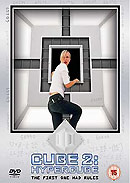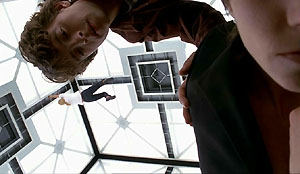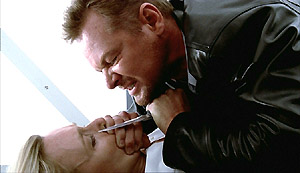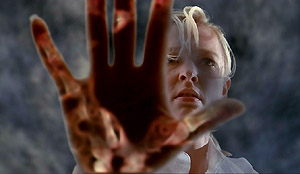
|
CUBE 2 - HYPERCUBEDirector: Andrzej SekulaStarring: Geraint Wyn Davies, Kari Matchett, Neil CroneA group of strangers are trapped in a structure where the rules of physics no longer apply. Well, here's a surprise: a straight-to-video sequel that doesn't disgrace the original movie! The first film was a quiet cult hit, grossing more than twice its modest budget and doing very respectable business on VHS. Sadly that's still not enough to give the sequel enough clout for a theatrical release, because it's certainly a step or three up from the usual video fodder.
The two film's aren't closely interlinked, but viewers who have seen the 1997 film will definitely have the advantage on anyone who's coming to it's sequel cold. All the characters are new, presenting a new combination of personalities (this time the occupants of the cube include a computer games designer, an attorney and a theoretical mathematician). The characters are sketchily drawn, and there are few opportunities for them to use the skills that they may have acquired in their real world lives in their new environment.
The disc has 5.1 audio, at 448kbps. The audio mix isn't terribly elaborate (there was a conscious decision not to have the same constant background noises as the original movie, but there are nevertheless plenty of effective gurgles as the rooms reconfigure, and generally a nice sense of presence and atmosphere). Norman Orenstein's quirky ambient score is well-served by the mix, and, even when there's plenty going on at once, the dialogue is clear. The disc has no subtitles.
There's plenty of behind-the-scenes footage included within the The Making of The Cube segment, which runs for about thirty-five minutes in total, and provides a pretty comprehensive look at the techniques used to shoot the film, and to create its effects. This is broken down thus: Opening Sequence is a detailed examination of the opening title sequence (7m). Virtual Cube is a five-minute demonstration of how a CGI set was created (and used in about a hundred shots in the movie, usually in special effects shots, or for shots which required especially dynamic camera moves). Moving Cubes explains some of the science behind the cube concept, and how this was applied to some of the key sequences in the film, including a scene where one room passes through another (8m).
The End of the Cube (7m) looks at how the last couple of minutes of the film were created. To say any more than that would spoil things! A separate, sixteen-minute section is devoted to the film's Green Screen Effects. This section features the full version of a sequence whose existence is revealed in The End of the Cube: an extended, alternative version of the film's climactic moments. This footage is a mixture of completed and unfinished footage. After this, several scenes are presented in more or less their raw state (sometimes with sound effects and music, sometimes simply with on-set audio). This is a nice addendum to the various Making of... segments. These scenes are presented without any annotation, but viewers who were paying attention during the Making of... section will know what's happening. This section is presented in non-anamorphic widescreen, but the picture quality is very reasonable. Two TV spots, Reason and Terror (thirty and fifteen seconds respectively) are offered, and do a good job of hard-selling the film. A theatrical trailer (1'30") is also offered, but it's not as effective as the TV spots (it spends the first third of the film reprising clips from Cube). It does, however, contain shots from a number of key moments from the film, and is best avoided until the viewer has seen the film. Mosaic have created an excellent disc to complement a rather nifty film. The disc has a ring of quality about it (including some nice animated menus), and the company should be congratulated for not simply resorting to using fluffy EPK material. (Actually, that's arguably also it's biggest weakness - there's no tangible contribution from the film's cast, which will certainly disappoint fans of Forever Knight's Geraint Wyn Davies). For once UK fans have the edge on their US brethren. While it remains to be seen what the Region 1 disc will eventually offer, UK buyers certainly won't be short-changed by Mosaic's version. |


 Fans of
Fans of
 Mosaic
Entertainment has done an
excellent job transferring the film to disc, and in offering buyers a good
selection of worthwhile bonus material. The film, directed and shot by
cinematographer Andrzej Sekula (whose director of photography credits include Reservoir Dogs and
Pulp Fiction), takes place almost entirely within brightly-lit sets
(sleeker, more expensive-looking versions of the rooms in the 1997
movie). This is perfect for DVD encoding, and the result here is very appealing. The image is sharp, with excellent contrast
range, detail and colour balance. Mosaic don't have a stellar reputation,
and, frankly, it could have
been appreciably worse. There's some edge-enhancement, which is
occasionally a problem since the white walls constantly provide stark contrast. There's usually so much going on,
and plenty of camera movement, that it's rarely distracting. Grain isn't a
problem either, and there are no obvious
signs of excessive noise reduction or shoddy MPEG encoding. There's a
fleck or two of dirt, but no more than you'd get on any brand new feature
film. The
film is presented in 1.78:1 ratio, with anamorphic enhancement, over both
layers of a DVD-9. The layer change isn't ideally placed, but at least
occurs where there's almost nothing happening. Average bitrate is a
healthy 6.44Mb/sec.
Mosaic
Entertainment has done an
excellent job transferring the film to disc, and in offering buyers a good
selection of worthwhile bonus material. The film, directed and shot by
cinematographer Andrzej Sekula (whose director of photography credits include Reservoir Dogs and
Pulp Fiction), takes place almost entirely within brightly-lit sets
(sleeker, more expensive-looking versions of the rooms in the 1997
movie). This is perfect for DVD encoding, and the result here is very appealing. The image is sharp, with excellent contrast
range, detail and colour balance. Mosaic don't have a stellar reputation,
and, frankly, it could have
been appreciably worse. There's some edge-enhancement, which is
occasionally a problem since the white walls constantly provide stark contrast. There's usually so much going on,
and plenty of camera movement, that it's rarely distracting. Grain isn't a
problem either, and there are no obvious
signs of excessive noise reduction or shoddy MPEG encoding. There's a
fleck or two of dirt, but no more than you'd get on any brand new feature
film. The
film is presented in 1.78:1 ratio, with anamorphic enhancement, over both
layers of a DVD-9. The layer change isn't ideally placed, but at least
occurs where there's almost nothing happening. Average bitrate is a
healthy 6.44Mb/sec. The
film is supported by a
commentary track, from producer / co-writer Ernie Barbarash and film
editor Mark Sanders (not, as has been reported, and listed on the menu
screen, from the director). The track is very informative, with Barbarash
filling in admirably in the director's stead, and Sanders interjecting
useful comments of his own. It's a fast-moving film (a lean
ninety-minutes), and the commentary keeps apace, while still making time
to point out interesting bits of trivia (noting that in one close-up shot
the serial numbers of a pair of
supposedly identical watches are different, for example). Barbarash also
makes a few interesting points that might interest fledgling film-makers (noting
that the he found the writing process more about reducing the film down to
its essential elements, rather than adding plot material that might turn
out to be superfluous).
The
film is supported by a
commentary track, from producer / co-writer Ernie Barbarash and film
editor Mark Sanders (not, as has been reported, and listed on the menu
screen, from the director). The track is very informative, with Barbarash
filling in admirably in the director's stead, and Sanders interjecting
useful comments of his own. It's a fast-moving film (a lean
ninety-minutes), and the commentary keeps apace, while still making time
to point out interesting bits of trivia (noting that in one close-up shot
the serial numbers of a pair of
supposedly identical watches are different, for example). Barbarash also
makes a few interesting points that might interest fledgling film-makers (noting
that the he found the writing process more about reducing the film down to
its essential elements, rather than adding plot material that might turn
out to be superfluous).  Razorsphere
(8m) dissects the film's big special effects set piece, showing how
the concept evolved, and including test shots of a number of alternative
designs, some of them quite radically different. Some of the more
elaborate effects shots are here broken down into their component
parts.
Razorsphere
(8m) dissects the film's big special effects set piece, showing how
the concept evolved, and including test shots of a number of alternative
designs, some of them quite radically different. Some of the more
elaborate effects shots are here broken down into their component
parts.